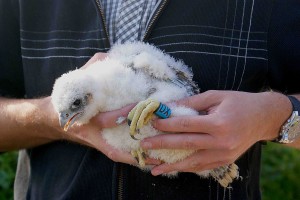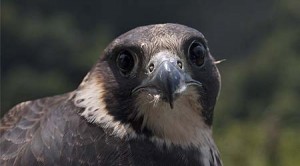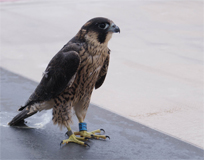The Peregrine Watch Point location is on Clifton Downs, at the south end of Circular Road, just north of the sharp bend where Circular Road meets Ladies Mile.
In recent years the Club’s activities have focused on public information events where we help people to find the Peregrines in the Gorge over two weekends in June and July. The birds can give spectacular displays as the parents train the juveniles to develop their flying and hunting skills.
If you would like information about the Peregrine Watch events please contact Gareth Roberts via our Contact page.
A real success story; from one or two nesting sites in the 1990’s, to possibly twelve in the present day.
Peregrines once bred in the Avon Gorge but along with many other species of birds of prey, they went into sharp decline due to the impact of harmful pesticides in their food chain. The situation recovered in the 1970’s and breeding Peregrines returned to the gorge in 1990. From 1991 the Club organised and led breeding watches of these birds, see the article at foot of this page.
During the winter months the adult Peregrines will be hunting and perching on the cliffs in the Avon Gorge, on buildings in Clifton and by the Cumberland Basin, with the juvenile birds sometimes still begging for food.
Our new peregrine leaflet is produced by the BOC and the Avon Gorge and Downs Wildlife Project
When possible the chicks are ringed at three weeks old by a BTO specialist. Ringing is allowed as Peregrines have extra protection licence to visit the nest that requires a special schedule 1 licence. A unique metal identification ring is fitted on the right leg and a blue plastic colour ring fitted on the left leg. The colour ring has a unique two-letter combination, such as GY. The colour rings are spotted when the peregrines fly away from the Avon Gorge and set up home elsewhere. Chicks from the Avon Gorge have been spotted in the Chew Valley, on Tewkesbury Abbey and in east London. Their movements are helping to discover where peregrines travel from the Bristol area and how they are helping to increase the populations in the Midlands and the north-east of England.
If you spot any colour-ringed peregrines, please report details to the British Trust for Ornithology via Euring.
2023 Season summary
The birds nested late, below the Watch Point, 2 juveniles fledged, on 25 and 26 June
2021 Season summary
The birds nested at Seawalls. Four juveniles fledged, the first two on 7 June
2022 Season summary
Three chicks fledged from the Avon Gorge, but only two survived into July
2020 Season summary
One chick fledged from the Avon Gorge. Two chicks fledged from Finzels Reach/Castle Green, alas, one drowned in the canal below the nest.
2019 Season summary
The Avon Gorge Peregrines hatched – 3 chicks and they were ringed 24th May 2019 Photos attached of each one. One fledged in a rain storm on 11 June and was lost, the other two fledged successfully on 12 June.

2018 Season summary
The gorge Peregrine nested as usual, there were 2 chicks that fledged 17th June.
The site at Finzels Reach produced 2 chicks and they too fledged on 17th June
2017 Season summary
The Peregrines did not produce any young – egg predation suspected.
2016 Season summary
The Peregrines hatched 3 and fledged 2 – rings LY and LZ
2015 Season summary
The Peregrines had 3 chicks in 2015 which were colour-ringed JS, GZ JV. The nest was on the Leigh Woods side for the first time in 20 yrs.
2014 Season summary
The Peregrines had one chick in 2014 and was colour-ringed with a blue ring and black letters CH. If the chick is spotted during its lifetime we will know where it was hatched without having to catch it again. During the next few years the young bird will begin to venture further afield, exploring other parts of the city and country, and moving up to a few hundred miles away.
2013 Season summary
In 2013 the pair of Peregrines in the Gorge reared four chicks which all successfully fledged and left their nest in June. They were not ringed this year.

2012 Season summary
In 2012 the peregrines reared three chicks in the Avon Gorge. They were ring
ed on the 21st May at around 3 weeks old with blue colour rings and black letters DX, DY and DZ. The first chick fledged on June 13th, followed by the other two a few days later.
Meanwhile, a single male chick fledged in the centre of Bristol by Castle Park. Not long after fledging it got into trouble when gulls mobbed him. He almost drowned. Ed Drewitt brought him home (almost dead), dried him out, and by the next day he was fighting fit. He was released the next day and was seen throughout the summer and autumn with his parents learning how to hunt.
2011 Season Summary
In 2011, the Peregrines reared another five chicks! The young birds were ringed towards the end of May and given colour rings DF, DG, DH, DJ, FK.
2010 Season Summary
In 2010, the Peregrine chicks were ringed in mid-May. There were five chicks which is unusual for Peregrines, although a brood of five was recorded at this site in 2008. When a female lays a clutch of five eggs, it is common for her to repeat this in future years. The chicks were colour ringed BS, BT, BV, and BY. They were all healthy, even weights and looked to all be female. The event was filmed for the BBC’s Springwatch and appeared on our screens at the beginning of June. All five chicks fledged successfully.
A brief story on how it all began.
The Avon Gorge Peregrines – a 20-year saga
It began with a wicked deed and grew into one of the crowning glories of Bristol’s wildlife scene – the BOC’s Peregrine protection effort in the Avon Gorge.
Back in 1990, a small number of local bird-watchers had been entranced by the return of Peregrine falcons to a cliffside eyrie near Sea Walls. Among the watchers were Tony Scott, Robin Prytherch and Alix Lord (and apologies to anyone I have omitted). That year Alix and I went with the BOC on a spring holiday to Fair Isle while Robin and Tony nobly stayed behind. It was a wonderful trip, made sadly even more memorable by a message to Fair Isle from Robin: some mindless thug had clubbed the young falcons to death in the nest.
That, as they say, did it. A group of BOC Peregrine fans vowed that should never be allowed to happen again and plans were laid for the watch that has continued, in varying forms, to this day.
The first vigil was in 1991, with a delightful, keen post-grad university student, memorably named Tertia, answering our call for someone to coordinate a watch on the nest. A team of volunteers from the BOC, the Hawk and Owl Trust and many non-attached individuals came together to fill the rota. (BBC Wildlife magazine kindly lent a mobile phone – the size of a car battery and twice as heavy – that would have cost around £1200 to hire for the 10 weeks of the vigil! How times change). There followed 1500 hours of Peregrine watching, note-taking, alarms and occasionally unpleasant confrontations with those who saw Peregrines as no more than murdering vermin. But, of course, it all ended happily, with three young falcons successfully fledged – and the obligatory party when they did.
I took over the rota-organising for the next few years – Tertia had moved away – and the rest is happy, happy history. The Peregrines had returned to a cliff-face they had vacated something like a century before and the BOC had helped them to stay. We hoped, with fingers crossed and wood touched, that maybe, just maybe, the Peregrines would become a Bristol sight-to-see. But I doubt that any of us would have forecast that 20 years on, they were still thriving under the watchful eyes of their human friends. And that I would be writing this wildlife story with such a happy ending.
Mike Lord


